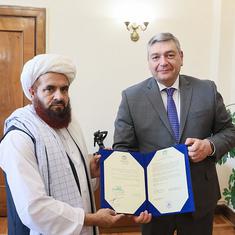This series arises from my need to share the works of musicians, or recordings of music, that I feel have been either overlooked, or forgotten, or inadequately acknowledged. It originates from a wish to look at the arts not as a static thing, where everything has already been decided, and where we only need to agree to what we’re told to listen to or read, but as a shifting field which at any point of time leads to unsettlement, surprise, and genuine joy.
We live in a time of unprecedented affirmation of a particular kind: the affirmation of success. At the same time, when it comes to, say, North Indian classical music, there’s a pessimistic consensus that there are few “great” performers among us. Both the affirmation and dismissal are related to a diminishing of curiosity.
I don’t think an age in which an artistic efflorescence occurs is the result of a purely accidental agglomeration of talent at a particular time. It also requires audiences of sensitivity and courage, not to mention patience: listening – like reading, or writing, or singing – is something that must be learnt. Artistic flowerings are put together by exceptional artists and exceptional listeners, readers, and viewers.
The recordings I’ll be sharing here are of the following varieties: first, of exceptional musicians we’re not sufficiently conscious of; second, recordings that shed light on a particular side of a great musician’s work that we don’t know enough about; third, an interpretation of a familiar corpus of music that sheds new light on it, but which is known to relatively few. I’d like to reconsider artists who are well-known without us quite knowing, or addressing, why they’re well-known, and who hardly figure in conversations that are supposed to be about music but are, increasingly, about a limited number of figures.
Other variants will emerge as I keep adding. I’m not going to restrict myself to any one kind of music, and I’m not going to try to be representative. I’d like this to be a personal record, the result of years of thought to do with songs and performers I haven’t been able to forget in spite of their often being forgotten. YouTube and Soundcloud will help me here. YouTube, especially, should be celebrated for being among the best things about the internet in containing acts of retrieval whose impact will, in the future, become clearer.
Barkat Ali Khan

I begin at random with Barkat Ali Khan (1908-’63) of the Patiala gharana. As I started to learn the khayal in the late seventies, I heard of Barkat Ali only in his capacity as a bit-player in the life of the greatly celebrated khayal and thumri singer Bade Ghulam Ali Khan, Barkat Ali’s older brother. Hindustani classical lore is full of unverified gossip, often meant to aggrandise one figure at the expense of another, and the anecdote I heard had Bade Ghulam Ali starting out as a sarangi player (it’s true he could play the sarangi), with the singer in the family being Barkat Ali Khan.
According to this account, Barkat Ali mocked his older brother one day, and Bade Ghulam Ali, provoked, decided to set aside the sarangi and devote himself to vocal music, going on to become the greatest virtuoso of his generation. The story is improbable, although it captures the insecurities and egotism the milieu feeds on. I mention it because it was how I got to hear of Barkat Ali Khan.
One reason why many of us haven’t heard of him may be because he became a Pakistani upon Independence; his older brother, already by then one of classical music’s most prominent figures, settled, famously, in India. But I don’t get the sense he’s very much on the minds of Pakistanis either. I spotted a long playing record of Barkat Ali Khan’s thumris a lifetime ago in Mumbai’s Rhythm House: the only record available there of his music.
It contained four thumris sung at someone’s home (you can hear the occasional groan or sigh of admiration) in Khamaj, Mishra Pilu, Bhairavi, and what sounds like a mixture of Pahadi and Jhinjhoti. At least three of them, especially when the tabla doubles the time signature in the laggi, have the abstracted air of accompanying a dancer, which is what the thumri was created for.
Barkat Ali Khan has an incomparably melodious, uninsistent voice. It is full-bodied but not loud. The idea of Patiala gayaki that’s come to be conflated with Bade Ghulam Ali Khan is virtuosic, even exhibitionistic – especially with respect to taankari and embellishment. This is true of Bade Ghulam Ali’s drut (fast) khayals and thumris alike.
Though Barkat Ali Khan doesn’t attempt, or can’t achieve, his older brother’s tayyari, his singing is full of jewel-like intricacies, each detail perfectly executed. But what attracts me more is his calm: the saturated timbre of the voice becomes everything, and we return with it to the basic principle of listening: to the inexplicable yearning of sur, or tone, or melody, without distraction. In this, Barkat Ali is a truer singer than his brother, who only achieved a similar tranquillity in one recording of thumri/kajri: ‘prem agan jiyara’ in Manj Khamaj.
Here’s Barkat Ali Khan singing a thumri in Khamaj.
And here’s the sublime, delicate Pahadi with inflections of Jhinjhoti.
For decades these recordings have languished, while vinyl records and CDs have gone in and marginally out of extinction. They’re now consigned to a corner of the overpopulated storehouse of Gaana.com. Someone from Saregama, the company that unwittingly acquired these treasures from HMV, has now put them up on YouTube. Good things come to those who wait (as they say), though they may come unannounced.
Amit Chaudhuri is a writer, a Hindustani classical vocalist, and a composer of crossover music.










